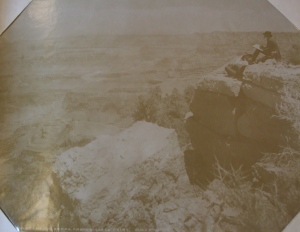RESPONSE #4 Elin Jones
Our session this week, with Chris Laoutaris of the University of Birmingham’s Shakespeare Institute, asked us to look at objects through a different lens. Objects as technologies, according to the theories surrounding posthumanism, see our decision-making processes informed and silently shaped by continuing quotidian contact with them. Looking up birth and death dates of historical figures on a smart phone for example, we get the sense that we are choosing our internet browser, to inevitably look at the Wikipedia article which makes up the top of the appearing list, and to then browse through the rest of the information in front of us. These ‘decisions’ however, have already been made for us on many levels by non-human agents; we are funnelled towards the end result through a series of the most obvious options which the object we hold presents us with. Although I don’t remain wholly convinced by the argument that we are in fact living in a ‘posthuman’ age (after all, are we not in fact directed through these decision-making processes by the human owners of technology corporations and the billions of other humans who have engaged with these objects before us?), the concept that our relationship with modern technology opens up possibilities for our thought processes, and thus the end-result, to be morphed, seems to be convincing.
But – how modern is this relationship? Posthumanist N.Katharine Hayles posits that perhaps we have always been posthuman, and that our thoughts and actions have been historically shaped by our relationship with tools and objects. As our discussion moved back in time to look at early modern automata, one theme which I think came across particularly strongly was that of artifice. The wonder, and often fear, which Laoutaris showed us that early modern automata inspired seems to have been based on the belief that the artificial could supplant the real; the false and the true would become indistinguishable. This understanding was bolstered by the alchemical belief that metal was a living element. A man made of metal could therefore be physiologically akin to a man of flesh.
The uneasy relationship between the natural and artificial was palpable in these objects, and the boundaries between the two were continually blurred. Looking at my photo album again, I began to ask myself where these lines were drawn in relation to my object. The camera claims to ‘capture the moment’, to record, to document, to point out a truth. Photograph albums are kept today as relics of a person’s or group’s experience, and the rise and rise of social networking sites has seen photographic images used increasingly as a form of social capital; proof of weekends well-spent, and a life enjoyed away from the computer or phone, where we endlessly and ironically document the events that make up this life.
The filters which human experience goes through to end up as a photograph are, quite obviously, manifold. The camera as an object dictates the way it is held and pointed at the subject (perhaps feeding the posthumanist argument), and the way it is held subsequently dictates the routine postures which we as humans assume. We pout, turn, smile, and ostensibly stop what we were actually doing in the first place, for this little box. In the age of the digital camera, the photographic ‘record’ is further stunted by our selection of which relics are worth keeping as a ‘memory’.
Although much of the technology is new here, the concept of artifice within photography is not. Some of the first publicly consumed photographs, those of the devastation of the American Civil War, were posed and staged extensively to create a more dramatic impact. My late nineteenth-century travel album also represents a highly complex relationship between the artificial and natural. As in the photograph above, supposedly natural human posture is used throughout to highlight the majesty of the natural world. If the album was, as I am inclined to believe, an attempt to organise and categorise the vast panoply of American life and progress, the photographs within it present us with an interesting story about desired memory. The assemblage of these photographs demonstrates beautifully the ability of the photograph, as conception and material object, to define the past and present as what we consider to be truth, and to not just blur, but at times remove the line between artifice and experience in our memories. How the men and women who flicked through this album understood the photographs as a construct, and how we attempt to locate any kind of ‘evidence’ within photographs of the past are questions which I am continuing to explore.

